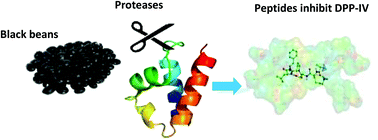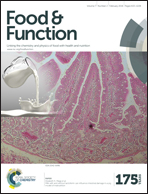Optimization of enzymatic production of anti-diabetic peptides from black bean (Phaseolus vulgaris L.) proteins, their characterization and biological potential†
Abstract
The aim was to optimize the production of bioactive peptides from black bean (Phaseolus vulgaris L.) protein isolate and to determine their biological potential using biochemical and in silico approaches. Protein fractions were generated using eight commercially available proteases after 2, 3 and 4 h and 1 : 20, 1 : 30 and 1 : 50 enzyme/substrate (E/S) ratios. The best combination of conditions to generate anti-diabetic peptides was with alcalase for 2 h and E/S of 1 : 20; with inhibition values for dipeptidyl peptidase IV (DPP-IV, 96.7%), α-amylase (53.4%) and α-glucosidase (66.1%). Generated peptides were characterized using LC-ESI-MS/MS. Molecular docking analysis was performed to predict individual peptide biological potential using DockingServer®. Peptides EGLELLLLLLAG, AKSPLF and FEELN inhibited DPP-IV more efficiently in silico through free energy interactions of −9.8, −9.6 and −9.5 kcal mol−1, respectively, than the control sitagliptin (−8.67 kcal mol−1). The peptide TTGGKGGK (−8.97 kcal mol−1) had higher inhibitory potential on α-glucosidase compared to the control acarbose (−8.79 kcal mol−1). Peptides AKSPLF (−10.2 kcal mol−1) and WEVM (−10.1 kcal mol−1) generated a lower free energy interaction with the catalytic site of α-amylase in comparison with acarbose (−9.71 kcal mol−1). Bean peptides inhibited the tested enzymes through hydrogen bonds, polar and hydrophobic interactions. The main bindings on the catalytic site were with ASP192, GLU192 and ARG 253 on DPP-IV; TYR151, HIS201 and ILE235 on α-amylase; and ASP34, THR83 and ASN32 on α-glucosidase. For the first time, a systematic evaluation and characterization of the anti-diabetic peptides from black bean protein isolate is presented with the potential for inhibiting important molecular markers related to diabetes.


 Please wait while we load your content...
Please wait while we load your content...